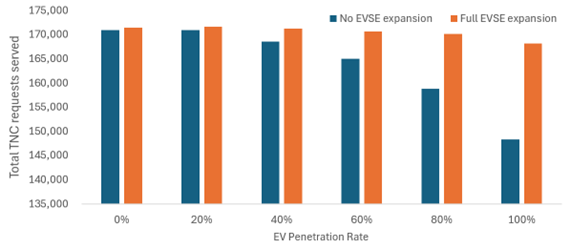TNC Electrification
Published: 2025 February
Electrification Can Help Shared Fleets Reduce their Cost
Fleet operators could potentially benefit from lower energy cost and reduced energy consumption by switching to electric vehicles, especially in an environment where people would consider utilizing Transportation Network Companies (TNC) operators’ ride-pooling services. This research underscores the importance of a holistic approach to fleet electrification, combining infrastructure development, technological innovation, and operational optimization to lower costs for businesses and consumers, and reduce dependence on foreign energy sources.
Key Insights
This study, conducted by researchers at Argonne National Laboratory, explores the impact of electrifying transportation network company fleets on fleet performance and energy consumption. Using agent-based simulations, the research evaluates various scenarios with different levels of TNC demand, battery electric vehicle (BEV) penetration, expansion of electric vehicle supply equipment (EVSE), and advancements in vehicle technology.
- Fleet Performance: Electrification can lead to increased waiting times (up to 10%) and reduced matching rates (13%) due to charging downtime. Expansion of EVSE can mitigate these impacts, maintaining fleet performance even at high electrification rates.
- Energy Consumption: Full electrification can reduce TNC fleet’s energy consumption by 77% and increase TNC fleet fuel economy by 4.6 times.
- Vehicle Technology Innovation: Vehicle technology improvements alone significantly contribute to energy consumption improvements.
- Economic Impacts: The energy savings from electrification reduce cost of operations, like energy and maintenance costs. These savings can support lower fares, better driver wages, or business expansion, boosting economic activity.
Actionable Stakeholder Takeaways
- Prioritize EVSE Expansion: To support fleet electrification, cities and TNCs should invest in expanding charging infrastructure, particularly fast-charging stations, to reduce downtime and improve service reliability.
- Incentivize Technological Advancements: Policymakers should encourage research and development in vehicle technologies to enhance fuel efficiency and energy savings, complementing electrification efforts.
- Optimize Fleet Operations: TNCs should explore strategies to optimize fleet operations, such as dynamic routing and scheduling, to minimize the impact of increased charging events on service performance.
- Set Realistic Electrification Goals: TNCs and policymakers should set achievable electrification targets, considering the current state of EVSE and vehicle technology, to ensure a balanced approach to reducing emissions without compromising service quality.
Maximum TNC request is achieved by coordinating BEV and EVSE deployment, leading to 15% increased revenue. EVSE expansion enables the system to have higher electrification rate of TNC fleets without impacting the fleet performance. A coordinated vehicle electrification adoption and EVSE deployment is critical to lower costs for businesses and consumers.
 Figure 1. Benefits of BEV and EVSE Deployment Coordination
Figure 1. Benefits of BEV and EVSE Deployment Coordination
Reference: Huang, Y., Gurumurthy, K.M., Mansour, C., Zuniga-Garcia, N., Auld, J., 2024. Shared Electric Vehicle Fleet for Stable and Fair Ride-Sharing Service. Presented at TRB’s Transportation Symposium on Environment, Energy, and Livable Economies, Aug 25 - 28, 2024, Denver, CO.